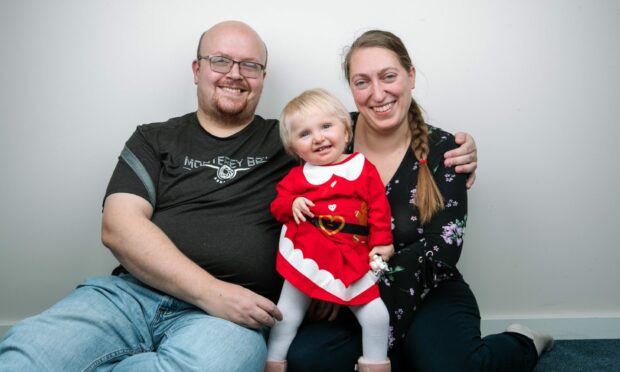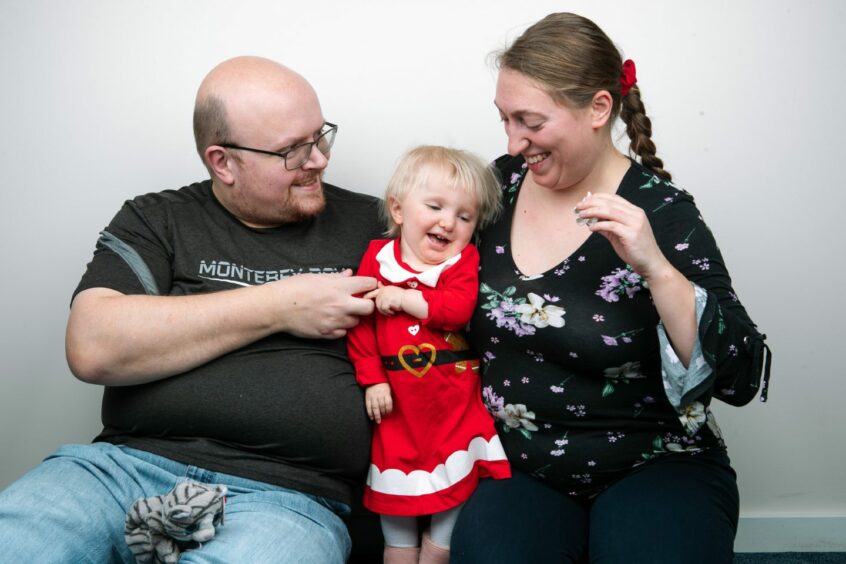It was only a tiny step but to the parents of little Isabella Winfield it was another astonishing milestone in a miraculous journey.
Margaret Paluszynska and Richard Winfield have described the moment their 18-month old daughter, who has a rare muscle weakening illness, took her first steps thanks to a £1.79 million drug prescribed just after she was born.
Isabella, from Archiestown, near Aberlour, was youngest child in the UK to be given the single-dose drug Zolgensma back in June 2021, and among the youngest in the world.
Doctors and her family hoped it would transform her life.
Without it, she may never have been able to sit, stand or walk.
Isabella was born in 2021 with Type 1 SMA (spinal muscular atrophy), the most severe form of the rare degenerative illness that occurs in only three cases each year in Scotland.
It affects the motor neurons, nerve cells located in the spinal cord that control voluntary muscle movement. Because the muscles cannot respond to signals from the nerves, they atrophy – weaken and shrink – from inactivity.
It also causes a range of life-shortening health issues, including breathing and swallowing difficulties.
‘It was a complete surprise’
Isabella is one of only two infants born in Scotland who have so far been treated with the potentially life-saving drug – a gene therapy – described as the world’s most expensive.
There was no guarantee, however, the ensuing treatment would work and at the time her translator mum, 36, and IT trainer dad, 37, did not dare to dream that their daughter would even sit, much less take her first steps, albeit with a little support.
Today Isabella’s parents and her doctor told of the significance of the development.
Ms Paluszynska told The Sunday Post: “I wasn’t expecting it. I didn’t think she was ready. It was a complete surprise. It is the Christmas gift we couldn’t even dream of.”
Mr Winfield added: “It was never set in stone that she would walk, the doctors always said the chances were 50-50, that she might, but not to get our hopes up. It is truly remarkable. We couldn’t be happier.”
Glasgow-based paediatric neurologist Iain Horrocks explained: “Without her parents’ vigilance there is little chance we would have treated her so early and therefore little chance she would have progressed developmentally so far so quickly to achieve this landmark milestone.
“Isabella’s success is a combination of very early treatment, with committed and aware parents who are tuned into her every requirement. This really is a success story we can be proud of in Scotland.”
A moment to remember
Reliving the landmark moment, proud mum Ms Paluszynska said: “I had been trying to encourage her to stand for a few months, with me stabilising her hips in case she fell. It was a slow build up, one day for three seconds, another day a little bit longer, and with me lessening the support to let her bear more weight herself.
“Then when we were in the park recently I tried to see if she would stand alone and unaided on a bench with her back against the arm rest. I stood close but let her go altogether. She managed it, so I let her do it a few times.
“Then a few days later, I tried doing it again, but allowed her to rest her hips against my hands for a little weight bearing support, and she just put one leg forward, then the other and before I knew it, she was on the other side of the bench.
“Although she doesn’t yet have the core strength to walk entirely unsupported, the steps are completely her own, she moves her legs herself. It’s amazing.”
A step in the right direction
Isabella’s family do not know how long it will be before she gains the strength to walk entirely independently. And they say she may, in the future, still need the occasional use of crutches or a wheelchair.
However, they are thrilled with her progress so far and are grateful to have received the drug on the NHS.
Her mum said: “For the first 12 months of her life every little improvement felt like it took forever and even then it wasn’t massive. And then, after her first birthday, that changed.
“The first big milestone came in June when she was lying on her back and managed to roll to one side and then to the other. She was finally starting to do things for herself, her leg and core strength were coming and she has literally been on a roll ever since.
“From where she was at in June, to taking steps now, is a staggering development and one we could not have dared to hope for when she was born.
“Now, seeing her progress, we can be more confident that at some point she will catch up to a level where, apart from certain weaknesses, she won’t be too different to other kids. She might be more easily exhausted but compared to the fact that without Zolgensma, she probably wouldn’t be able to breathe without support, or feed without a tube in her tummy, it’s a very small frustration.”



Conversation